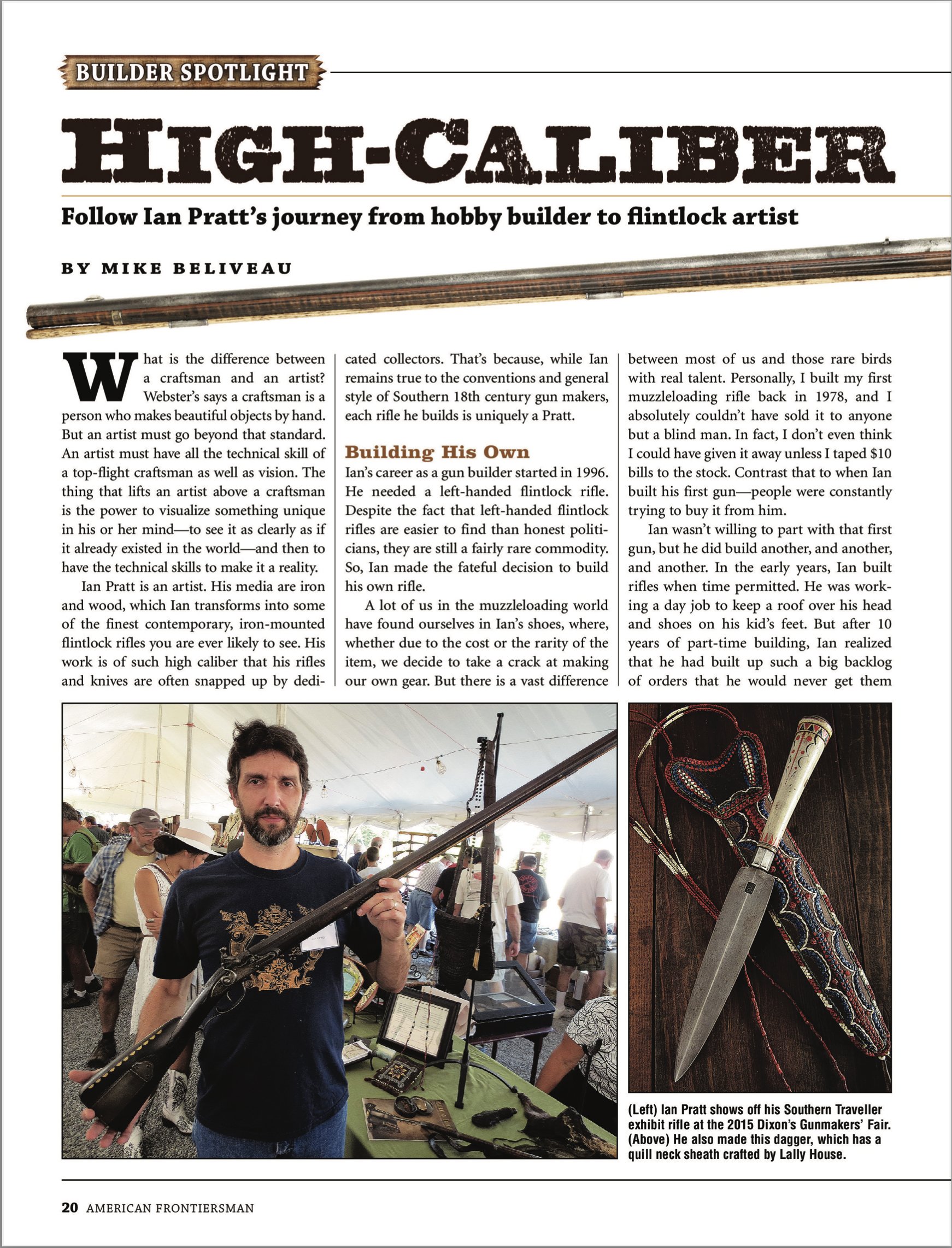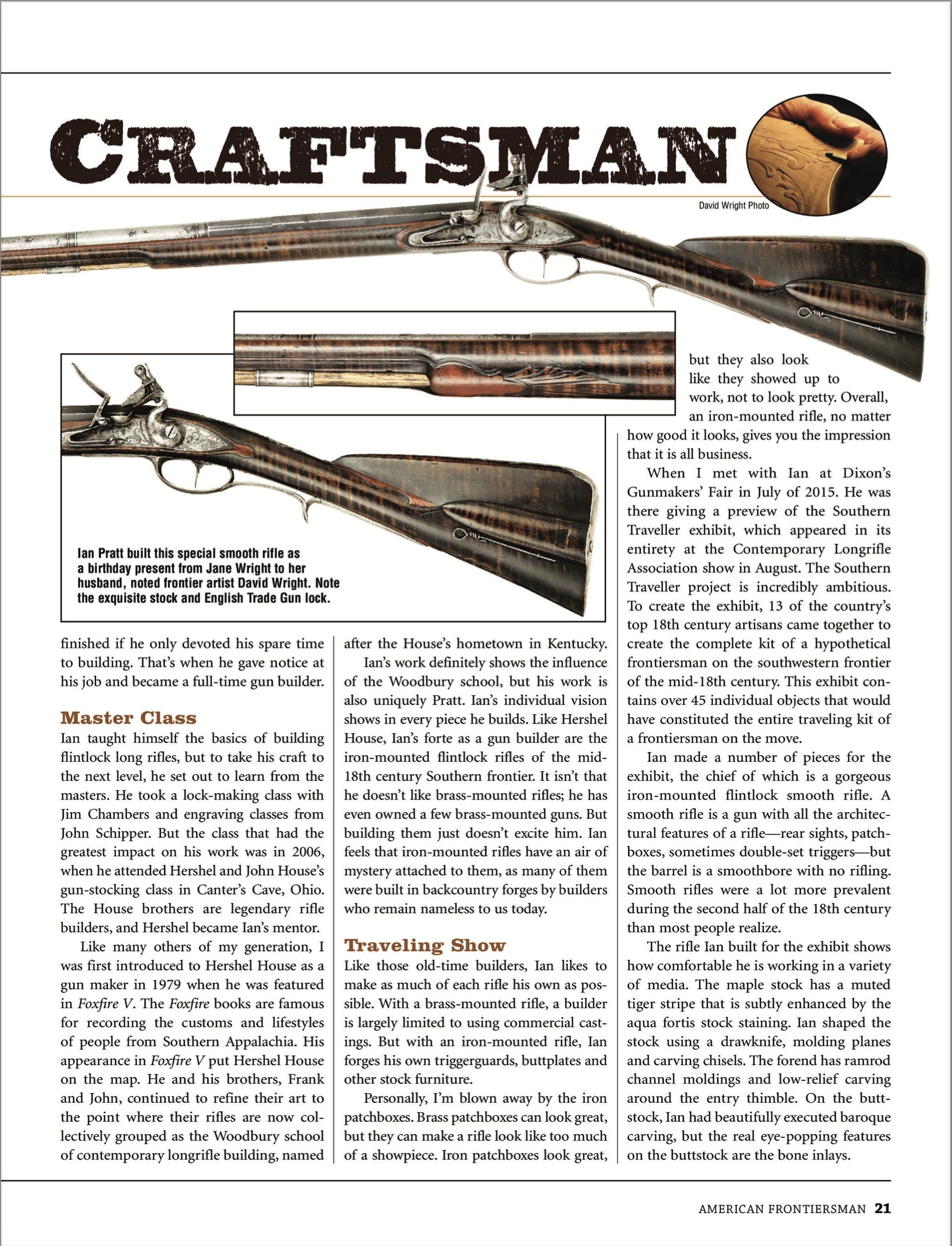High Caliber Craftsman
Ian Pratt builds rifles that are works of art.
What is the difference between a craftsman and an artist? Webster’s dictionary says a craftsman is a person who makes beautiful objects by hand. But an artist must go beyond that standard. An artist must have all the technical skill of a top-flight craftsman, but an artist must also have vision. The thing that lifts an artist above a craftsman is the power to visualize something unique in his mind…to see it as clearly as if it already existed in the world… and then to have the technical skills to make it a reality.
Ian Pratt is an artist. His media are iron and wood, which Ian transforms into some of the finest, contemporary, iron-mounted flintlock rifles you are ever likely to see. His work is of such high caliber that his rifles and knives are often snapped up by dedicated collectors. That’s because, while Ian remains true to the conventions and general style of eighteenth century southern gun makers, each rifle he builds is uniquely a Pratt.
Ian’s career as a gun builder started in 1996. Ian needed a left-handed flintlock rifle. Despite the fact that left-handed flintlock rifles are easier to find than honest politicians, they are still a fairly rare commodity. So Ian made the fateful decision to build his own rifle.
A lot of us in the muzzleloading world have found ourselves in Ian’s shoes, where, whether due to the cost, or the rarity of the item, we decide take a crack at making our own gear. But there is a vast difference between most of us, and those rare birds with real talent. Personally, I built my first muzzleloading rifle back in 1978, and I absolutely couldn’t have sold it to anyone but a blind man. In fact, I don’t even think I could have given it away, unless I taped ten-dollar bills to the stock. Contrast that to when Ian built his first gun, and people were constantly trying to buy it from him.
Ian wasn’t willing to part with that first gun, but he did build another…and another…and another. In the early years Ian built rifles when time permitted. He was working a day job to keep a roof over his head and shoes on his kid’s feet. But, after 10 years of part time building, Ian realized that he had built up such a big backlog of orders, that he would never get them finished if he could only devote his spare time to building. That’s when he gave his notice at the job, and became a full-time gun builder.
Ian taught himself the basics of building flintlock long rifles, but, to take his craft to the next level, he set out to learn from the masters. He took a lock making class with Jim Chambers, and engraving classes from John Schipper. But the class that had the greatest impact on his work was in 2006, when he attended Hershel and John House’s gun-stocking class at Canter’s Cave, Ohio. The House brothers are legendary rifle builders, and Hershel became Ian’s mentor.
Like many others of my generation, I was first introduced to Hershel House as a gun maker in 1979 when he was featured in “Foxfire V”. The Foxfire books are famous for recording the customs and lifestyles of people from Southern Appalachia. His appearance in “Foxfire V” put Hershel House on the map. He and his brothers, Frank and John, continued to refine their art to the point where their rifles are now collectively grouped as the Woodbury school of contemporary longrifle building, named after the House’s hometown in Kentucky.
Ian’s work definitely shows the influence of the Woodbury school, but his work is also uniquely Pratt. Ian’s individual vision shows in every piece he builds. Like Hershel House, Ian’s forte as a gun builder are the iron-mounted flintlock rifles of the mid-eighteenth century Southern frontier. It isn’t that he doesn’t like brass-mounted rifles. He has even owned a few brass-mounted guns, but building them just doesn’t excite him. Ian feels that iron-mounted rifles have an air of mystery attached to them. Many of them were built in backcountry forges by builders who remain nameless to us today.
Like those old time builders, Ian likes to make as much of each rifle himself as is possible. With a brass-mounted rifle, a builder is largely limited to using commercial castings. But, with an iron-mounted rifle, Ian forges his own trigger guards, butt plates and other stock furniture.
Personally, I’m blown away by the iron patchboxes. Brass patchboxes can look great, but they can make a rifle look like too much of a showpiece. Iron patchboxes look great, but they also look like they showed up to work, not to look pretty. Overall, an iron-mounted rifle, no matter how good it looks, gives you the impression that it is all business.
When I met with Ian at the Dixon’s Gunmakers’ Fair in July 2015. He was there giving a preview of the Southern Traveller exhibit, which appeared in its entirety at the Contemporary Longrifle Association show in August. The Southern Traveller project is incredibly ambitious. To create the exhibit, 13 of the countries top eighteenth century artisans came together to create the complete kit of a hypothetical frontiersman on the southwestern frontier of the mid-eighteenth century. This exhibit contains over 45 individual objects that would have constituted the entire traveling kit of a frontiersman on the move.
Ian made a number of pieces for the exhibit, the chief of which is a gorgeous iron-mounted flintlock smooth rifle. A smooth rifle is a gun with all the architectural features of a rifle, rear sights, patchboxes, sometimes double set triggers, but where the barrel is a smoothbore, with no rifling. Smooth rifles were a lot more prevalent during the second half of the eighteenth century than most people realize.
The rifle Ian built for the exhibit shows how comfortable he is working in a variety of media. The maple stock has a muted tiger stripe that is subtly enhanced by the aqua Fortis stock staining. Ian shaped the stock using a drawknife and molding planes and carving chisels. The fore stock has ramrod channel moldings and low relief carving around the entry thimble. On the butt stock Ian had beautifully executed baroque carving, but the real eye-popping features on the butt stock are the bone inlays.
On each side of the comb on the butt stock Ian inlaid 11 half moons, made of lightly yellowed bone. And the cheek piece is capped with a bone panel that is routed into moldings typically done on wooden check pieces. The result is a spectacular contrast with the dark wood of the stock. With its beautiful, understated stock carving, the hand-forged iron furniture and the hand carved bone inlays, this rifle is a true tour de force showing Ian’s mastery of a variety of materials.
In a sense this exhibit was a family affair, because Ian’s wife Maryellen, is a top flight artisan in her own right. She is well known for her leatherwork on hunting pouches. For the Southern Traveller exhibit, Maryellen made the knapsack, the hunting pouch, along with some smaller pouches.
One of the few commission pieces that Ian has made lately is a smooth rifle built for David Wright, the dean of frontier artists. David’s wife, Jane, wanted something special for their 20th wedding anniversary, so she went to Ian and said, “You know what David likes. Make him something special.” And something special is exactly what David got.
Like a lot of Ian’s work, the Wright smooth rifle started out more like a story than a simple piece of hardware. Ian pictured a rifle built for a working man by a frontier gunsmith who frugally re-used parts on hand from earlier guns along with other parts that he would have forged himself. But frugal doesn’t mean unsophisticated. Like many artisans of his time, our hypothetical eighteenth century gunsmith would have been influenced by, not only other gunsmiths, but also by furniture design and architecture of the late eighteenth century.
As Ian saw it in his mind’s eye, the gun would have been built in the mid-1770s out of parts made in an earlier decade, and newly stocked in native maple. The metal parts would originally have been polished bright, but time and handling would have added their patina. Likewise, the finish of the stock would show the effects of time and use.
Ian succeeded in telling his story in wood and iron. The heart of the Wright rifle is an amazing 51-inch long, 16 Gauge barrel that was manufactured by legendary barrel maker Don Getz. Ian took the basic octagon to round barrel, tapered it and added wedding bands at the transition. The left hand flintlock is one of Danny Caywood’s excellent Wilson English Trade Gun locks. All the other metal parts on the gun were forged or fabricated out of iron that by Ian.
It is hard to find a plank long enough to stock a 51-inch barrel, but Ian had been holding on to a special piece of maple from up the road in Ohio. That plank was fashioned into a slim, beautifully balanced gun stock in Ian’s shop.
As I mentioned, Ian built David a smooth rifle, which is a gun with a smooth bored, fowler barrel that also has typical rifle features like a rear sight and rifle-like stock architecture and furniture. The stock finish on this Wright smooth rifle is both complex and unique. The base stain is laid down by Ian’s homemade aqua fortis solution. That is finished with linseed oil. Then, over that, in strategic areas, Ian applied a red-oxide painted finish, like you see on some examples of eighteenth century furniture pieces. The painted finish is applied to the tops and edges of some of the moldings. The effect is both subtle and stunning.
The Wright smooth rifle is extraordinary. We should all get such wonderful anniversary presents.
You might wonder what a rifle builder does to unwind. In Ian’s case, when he gets tired of rifle making, he heads off to his forge to make a knife. And his knives are works of art in their own right. I got to see a dagger he made with a painted handle and a quill embroidered neck sheath made by Lally House; Frank House’s wife.
This dagger is very deceptive looking. I would have sworn the handle was made of bone, but it is actually maple. Ian used a base of white milk paint that he yellowed and wore away in spots. Then he applied blue and red geometric patterns using oil varnish colored with traditional dry pigments. The overall result, especially when paired with Lally House’s quilled sheath, is really eye-catching.
Ian also made the belt knife for the Southern Traveller Exhibit, and his wife Maryellen made the knife sheath.
Ian has reached a point in his career as a rifle builder where he is no longer going to be building rifles on commission from customers. From now on he is going to build rifles that he finds artistically interesting, and then he will put them up for sale. Based on the quality of work that I’ve seen, I think buyers will be lining up to get an Ian Pratt rifle.
Point of contact:
Ian Pratt
2035 Savage Rd
Peebles, OH 45660
Phone number: 330 814-3748

